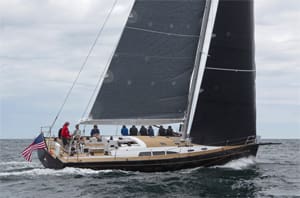Sailboat design, like many other things in our modern world, is ever changing and evolving. While some trends are fleeting, the real improvements are often based on new technology and on the changing needs and desires of the general market. With increasingly more powerful computers, designs and construction have gotten lighter and faster. New construction methods also allow for innovative features that make for a more comfortable boating experience. As it has been throughout boating history, much of these changes are also driven by racing and the need for speed. Trends and successes in racing boats are more often than not picked up by the production boatbuilders and applied to cruising boats.
Of course, not all changes are a result of the Grand Prix of boating. Catamarans, for example, are more a result of the popularity of these vessels in a Caribbean charter trade. Wide-open aft decks and well-lit salons, along with multiple cabins, make these boats ideal for island-hopping and playing in the tropics. Catamarans are also stable with little heeling. This tends to appeal to many would-be cruisers put off by “rail under” sailing on monohulls. The large deck space and open transoms for swimming make the cats perfect for the Caribbean and tropical waters.
Computer designs coupled with lightweight construction have allowed for improvements in both monohull and catamaran design. In racing, these stronger lighter hulls result in speed to take home the gold. For consumers, it means more room and amenities in addition to better, faster sailing. Let’s be honest: Any sailboat is a racing boat waiting for another boat to come along. This is one reason so many racing boat designs translate into good coastal cruising boats. Many sailors enjoy the local weekend races, and extra speed can also mean being able to make port ahead of bad weather. Faster boats translate into a better sailing experience. For manufacturers, this also translates into more boat sales.
It would seem one of the most profound influences on modern single-hull offshore sailing vessels has been the influence of the big, offshore, world-circling racing machines. Better known as the IMOCA 60, this boat first started appearing on the offshore circuit in the late 1980s. Over the years, the design has continued to develop. Unlike some of the older racing boats, such as the IOR boats, the IMOCA boats can translate well into coastal and offshore cruisers.
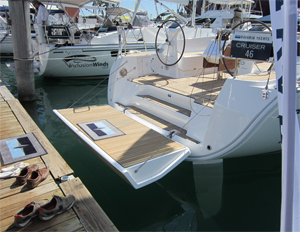 |
|
This Bavaria 46 has a drop-down swim platform that also could help in getting a crew-member back aboard after an MOB incident. |
|
Wayne Canning |
The rise of the skimming dish
In order to keep weight down and still have the ability to carry sail, these craft have gone from heavy ballast to wider beam and higher freeboard, taking advantage of form stability over heavy keels. This results in a long waterline from a plumb bow forward to a wider stern aft. Couple that with hard chines or moderately hard chines, and the result is a stiffer boat with a large cockpit and less heeling moment. These are desirable features for cruising boats and offer some of the advantages of a cat in a single hull. A wider beam carried aft means there is a wide open cockpit for entertaining and enjoying being outside. This wider beam also offers a larger cabin space that feels less cramped.
Stronger materials coupled with better construction allow for larger stronger windows and ports letting more natural light in below. Gone are the days of the dark cabin with little round port lights and claustrophobic sleeping quarters; today’s production cruisers have large open cabins with larger windows and hatches to allow plenty of natural light in. The wider beam and plumb bows allow for larger berths and private cabins as well. These are all some of the more desirable features of the catamarans, bringing the monohulls closer to the cats in terms of interior comfort. Wide sterns with higher sheer offer larger aft cabins as well, giving the option for more comfortable guest and owners’ cabins. These aft cabins also make for more comfortable sleep while at sea. The days of cramped quarter berths for use at sea are thankfully over.
The larger cockpits also have the benefit of giving more exterior real estate for enjoying nature and the company of friends. When racing, there is room for a good-sized crew to operate without getting in each other’s way as well. Because visibility can become an issue in wide cockpits, many builders are offering dual port and starboard helms — another innovation first seen on racing boats. These dual helms offer a better view for the helmsman, a safety feature for many boats. Another innovation taken from the racing boats is the removal of the transom coaming in favor of an open transom. This was originally done to save weight but has the advantage of making it easier to get on and off the boat from the stern. This is helpful with the higher sheerlines, as one does not have to scale a high sheer to get aboard. Many builders have taken advantage of this to go beyond the basic scoop transom to boats with fold-down swim platforms. Some innovative designs, such as the Hinckley Bermuda 50, have even managed to offer dinghy garages under the cockpit, a slick idea that will make you feel like you are on a megayacht while keeping your tender safe.
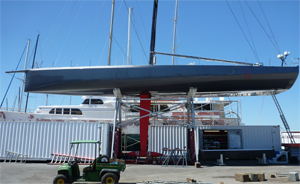 |
|
Modern keels for offshore race boats (above) are too extreme for voyaging boats, but bulbed keels (below) are regularly used to lower center of gravity and affect righting moment. |
|
Wayne Canning |
Keel developments
With these contemporary hull designs come new keel designs that work with the new hull shapes. The purebred racers have deep canting keels that are not really practical on a coastal cruiser. Production boats will have shorter wider keels with larger bulbs at the base. These keels are designed to work with the hull shapes for peak performance while maintaining a realistic draft needed for inshore and Bahamas cruising. Working together with the keel for stability is a spade rudder. With these modern designs, the rudder becomes part of a keel system offering lift to work with the keel to reduce heeling. Some boats are now using twin rudders that further help with this. At some point we may see ballasted rudders, but time will tell on that one.
Coupled with these new hulls and keels is a lighter and sometimes taller rig. Like with the other limitations on a cruising boat, the mast and rig are a bit toned down from their racing cousins, but a few things are carried over. Rigs, in general, are lighter and often use a discontinuous system of stays. This means not all stays are brought to deck level, and connections are made at the spreader tips. This allows for weight saving while still maintaining a stiff rig. Shrouds are attached at deck level aft of the mast, further adding to stiffness without the need for additional rigging. Let’s face it, the average cruising boat cannot carry a full crew of young men and women to handle the sails as the racing boats do. Most cruising boats are run short-handed. To help with this, the production cruisers are often fit with not only roller-furling headsails, but also roller-furling mains and in some cases roller-furling spinnakers or Code Zero headsails. All this makes sail-handling easier for the short-handed cruising sailor.
With all the good in the new designs, one has to ask what the downside is. One of the first things I was taught in the marine industry was that yacht design is the art of compromise. This is as true now as it was back when I was just getting my feet wet, so to speak. No design is perfect, and these new boats do have some drawbacks. Sailing and handling characteristics can be less forgiving with these modern high-tech designs. After all, the concept was not developed for short-handed sailing, but for speed offshore.
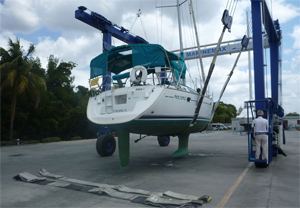 |
|
Wayne Canning |
Changes in handling
Although these new designs are faster, the price paid for that is a less forgiving boat. When relying on form for stability, one of the prices paid is sensitivity to fluctuating wind speed and direction. Gusts can cause the boat to load the helm and possibly round up suddenly. This sensitivity to gusty winds means reefing will need to be done a bit more often and sooner. Even downwind, the helmsman will have to stay quick on the wheel to avoid problems. Not only can this be tiring to the helmsman, but it can put autopilots to the test as well. Of course, some of this is made up for in faster passages, but it has to be kept in mind that these boats will work the crew a bit harder.
Another downside to these new cruisers is that the flat hull sections can cause slamming in a sea, making for a less comfortable passage. Downwind this may not be an issue, but when beating into a head sea it can make for a bumpy and somewhat uncomfortable ride. A lighter and faster hull also means the boat will be going into the seas faster and harder, further compounding the slamming effect. Once again, some of this may be offset by a faster passage — meaning less time experiencing bad conditions — and picking weather windows will still be important to comfort, as it is with most boats. On the plus side, these boats do have good windward performance and will beat the cats on a windward passage.
Another weakness in these boats is the keel attachment to the hull. Because the keels have a short cord, or width, they place large stresses on the hull structure supporting the keel. Builders have dealt with this by designing grid supports and increasing strength around the keel, but problems can still occur, particularly after a hard grounding. Keels used to be something taken for granted and, once installed, they were often not much considered. With these newer designs, more care needs to be given to this part of the boat. Keels should be carefully checked after any hard grounding, and maintenance inspections done at least every five years or so. On a positive note, with these designs it is not hard to drop and inspect the keel, bolts and supports, and it is not as intimidating a prospect as it was on older designs. Many yards are becoming better able to handle this work as well.
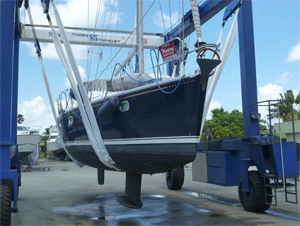 |
|
Fin-type keels add to performance but are more susceptible to grounding damage. They should be hauled and checked after any hard grounding. |
|
Wayne Canning |
Offshore modifications
Like most production boats, the new breed of coastal cruisers will take some modifications and improvements if they are to be used as serious offshore vessels. Some beefing up of the rigging may need to be done, and the same goes for the sail-handling gear. Grab rails will need to be added to the interior and possibly the cockpit, as the wide cabins and cockpits offer fewer handholds. Storage cabinets and lockers may need better latches to withstand sharper motion, and anchor-handling gear may need improvement. As these boats are faster, equipment such as AIS becomes more important as well.
Looking ahead to the future, we’ll see a trend in larger yet lighter boats offering more space. We will see more boats offer foils as a way to increase speed, although this will mean a boat that requires even more attention while underway. Some of that may be offset by computer integration to help control the sails and foils.
The new breed of offshore and coastal cruising boats do offer advantages: Faster passages, greater comfort and space while at anchor are a few of the most obvious. Sailing upright results in improved crew comfort and an easier time working on deck while underway, and larger hull volume also means more space for supply storage.
Wayne Canning is a marine writer and photographer and a licensed surveyor. He lives aboard his Irwin 40, Vayu, in Florida. Visit www.4ABetterBoat.com.

